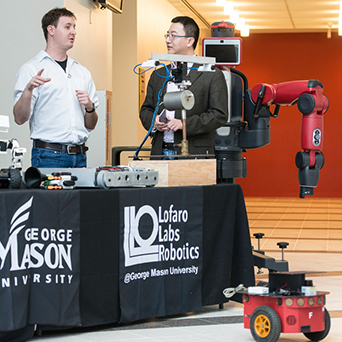We want them to analyze the risk of the communication system, how to hack it, and how to defend it.
Kai Zeng, an associate professor who teaches cybersecurity classes

Associate professor Kai Zeng (right) uses drones in his cybersecurity class to teach students how to hack and defend systems.
A cybersecurity professor is taking the use of drones to new heights, deploying them to teach his students how to defend against hackers.
“If you don’t know how to hack, you don’t know how to defend,” says Kai Zeng, an associate professor who teaches courses in the Cyber Security Engineering, BS Program. “You need to understand the vulnerability of your system.”
That’s why Mason Engineering students get hands-on experience in cyberattacks and defense using drones in Zeng’s 400-level cybersecurity engineering class.
“We want them to analyze the risk of the communication system, how to hack it, and how to defend it,” he says. Students learn to improve the security. The ultimate goal is to teach them how to prevent the drone from being subverted by an attacker, he says.
The drone labs for Zeng’s Secure Radio Frequency (RF) Communications course usually are conducted in the atrium of the engineering building.
Steve Zamory, a senior in the cybersecurity program, says, “The sanctioned WiFi attacks and competitive drone hacking in the class let us exercise our technical chops in a way that few of our classes allow. Dr. Zeng's enthusiasm for the topic is always apparent.”
Natalie Parke, another cybersecurity student, agrees. “Dr. Zeng uses hands-on activities in his classes to teach students information they’ll be able to apply later in their careers. Students love that.”
Experts nationwide are concerned about the cyber-physical security risk of drones, also called unmanned aerial vehicles, and the impact attacks on them could have on individuals, the military, businesses, and other organizations.
Consumers often use drones that aren’t secure, Zeng says. For instance, a drone can be controlled by a smart phone, but if the wireless link is not encrypted or secured, attackers could hack into the link and take control of the drone. Then they might crash it, use it as a weapon, or use it to videotape your home, he says.
Beginning next semester, instead of just flying drones in the atrium, students will have access to them in a new cyber-physical system lab where they can launch a drone, control it, and exploit the systems vulnerability remotely, Zeng says.
Participants will log into a website and run all the experiments through the internet. They’ll be able to do tests on the drone’s communication system, but there are restrictions on the its movements and the infiltrating ability of participants, he says.
The drone will be tethered to a frame, which can be fixed on the floor, and the drone will be programmed so that its movement is constrained within a range, Zeng says. “Safety is very important.”
The lab, funded by a $300,000 grant from the National Security Agency, may be the first of its type in the country, he says. It will promote U.S. Army Reserve education and eventually be open to the public, so users can learn about system vulnerabilities through remote experiments, he says.
Zeng, who is researching drone detection and secure car communication issues, says one day everything will be connected to the internet, including cars, refrigerators, and drones, so it’s critical that his students become topnotch cyber defenders.
Cybersecurity is a field where you solve “challenging problems that can benefit society, the community, and the public,” he says.
The sanctioned WiFi attacks and competitive drone hacking in the class let us exercise our technical chops in a way that few of our classes allow.
Steve Zamory, a senior in the cybersecurity program
